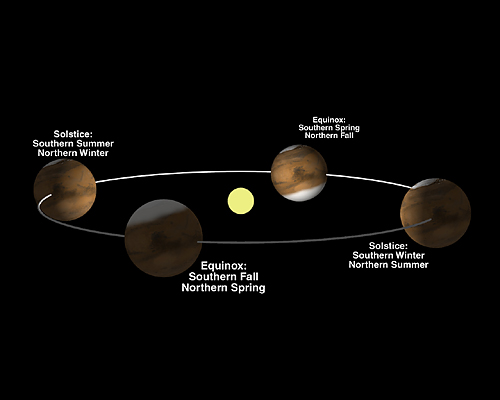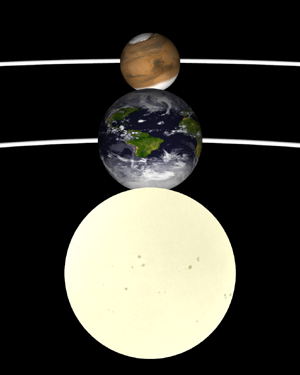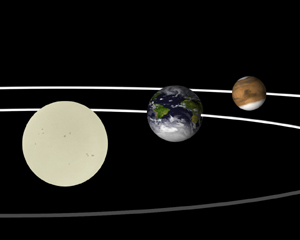

MGS MOC Release No. MOC2-285, 12 June 2001
|
Pictures from MOC daily global map images acquired every 2 hours between June 5, 2001 00:16 UTC and June 7, 2001 01:20 UTC. |
In 2001, Mars is at opposition on June 13-14 and makes its closest approach to Earth on June 21, when it is about 67 million kilometers (~42 million miles) away and subtends 20.8 arc-seconds in the sky. For observers in the northern hemisphere, it can be seen as a bright (magnitude -2) red object, low in the southern sky near the constellation Scorpius, in the evening. Southern hemisphere observers have a better view, as Mars is higher in the sky from that vantage. (See http://www.skypub.com/sights/moonplanets/0105marsreturn.shtml for more information.)
In homage to the many dedicated professional and amateur observers who have monitored Mars during its closest approaches over the years (see, for example, http://www.lpl.arizona.edu/~rhill/alpo/mars.html) we thought it would be fun to simulate the view from Earth using recent images from the Mars Global Surveyor (MGS) spacecraft orbiting 400 kilometers (249 miles) above the red planet. The data were acquired by MOC between June 5 and June 7, 2001. The Mars images were synthesized from a set of daily global map observations. Because MGS orbits Mars once every two hours, MGS can see the entire planet in twelve pole-to-pole image swaths. The images shown here were taken by the Mars Orbiter Camera (MOC) Wide Angle cameras and digitally wrapped onto a sphere. These cameras are "fisheye" lenses with a focal length of about 11 mm and an f/number of about f/6.5. The lenses image onto linear CCDs (Charge-Coupled Devices) with 3456 7-micron-square pixels. Earth-based telescopes often invert (top becomes bottom and vice versa) what is being viewed; the MOC simulations are presented here with south at the top to match this inversion. Clicking on each of the "Simulate Earth-based views," above, will take you first to a simulation of what the Hubble Space Telescope might see from Earth orbit at this time, and clicking on the Simulated Hubble view will provide the original MGS MOC image mosaic.
Not only is Mars at opposition June 13-14, 2001, and making its closest approach to Earth since 1988 on June 21st, on June 17-18 Mars will be at equinox, with the southern hemisphere turning to spring and the nothern hemisphere begins autumn. The diagrams below illustrate the opposition and equinox configurations of Mars.


Mars opposition occurs appromately once every 26 months when Earth, Mars,
and the Sun are all in a line with Earth between Mars and the Sun. In
our night sky, Mars is brightest during opposition; in June 2001 it
can be found in the vicinity of the constellations Scorpius and
Sagittarius. The large yellowish feature in this diagram is the Sun.

Mars opposition in 2001 occurs June 13-14. The planet's closest approach
to Earth takes place several days later, on June 21st.
All images and diagrams herein, Please Credit: NASA/JPL/Malin Space Science Systems
Malin Space Science Systems and the California Institute of Technology built the MOC using spare hardware from the Mars Observer mission. MSSS operates the camera from its facilities in San Diego, CA. The Jet Propulsion Laboratory's Mars Surveyor Operations Project operates the Mars Global Surveyor spacecraft with its industrial partner, Lockheed Martin Astronautics, from facilities in Pasadena, CA and Denver, CO.